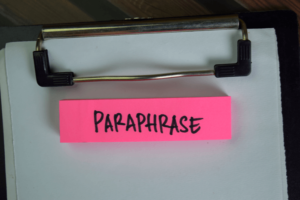How to Paraphrase (Without Plagiarizing a Thing)
Nov 13, 2024

When searching online, anyone can find numerous ways that are designed to help students achieve a good percentage of uniqueness in their texts. However, here one needs to understand the paraphrasing meaning, what to do first, what to pay attention to, and what kind of risks can be encountered and mitigated. To understand how to paraphrase a text correctly, we will dwell on the most important aspects of paraphrasing. To understand how to paraphrase a text correctly, we will dwell on the most important aspects of paraphrasing.
Paraphrasing a Text – What Is It?
Before we dive into the art of paraphrasing without plagiarizing a thing, let’s review and understand what is actually “paraphrasing”. Paraphrasing literally means “reworking”, “rewriting” of a text or using phrases, which differ from the original ones. Most often, in the academic world, this method is called “rewriting”. That is, your main task is to rewrite part of the work in such a way that it differs from the original text and original document. The main task of paraphrasing is to convey the main idea and content, while drastically changing the construction and wording of phrases in the text.
Paraphrasing is done in a variety of ways. For example, you can swap words, sentences, paragraphs. It is also possible to change words in the text, to replace them with those that are also suitable in meaning. Adding new definitions, adverbs, and participles to the construction of sentences is also part of the paraphrasing of a text.
Of course, a thorough paraphrasing is rather complicated, as it requires maximum patience, mental activity, and a lot of time from everyone (even a skilled writer), but in return, you get a completely unique text that will easily pass any anti-plagiarism test, either done manually by your teacher or automatically online.
Now you know what paraphrasing the text is, and you can proceed to learn the main steps that you need to follow in order to paraphrase without plagiarizing a thing.
Insufficient Paraphrase – Mistakes and How to Avoid
How to paraphrase a sentence? It is possible to do it by combining sentences, finding synonyms, changing the source of text, etc. However, sometimes people make mistakes by choosing incorrect words, which changes the context and negatively impacts the whole writing.
Here are common mistakes during the text paraphrase:
- Alteration of some words in a text
- Failing to consider the context of the text
- Inaccurate interpretation
- Using awkward and unclear synonyms
- Neglecting the key message of the next
To paraphrase properly you need to change entire phrases, not only individual words. Also, you don’t have to change original meanings and keep the text consistent all the time. If you are not sure what you are doing, look for the example of paraphrasing to understand what should be changed and what should be left unchanged. Identify the main points and rewrite the text without changing these points.
How to Paraphrase Without Plagiarizing a Thing – A Step-By-Step Guide
In order to paraphrase a text in the most effective and efficient manner, you need to take 5 simple steps.
Step #1.Let’s assume that you have already checked the text for anti-plagiarism online, which means that you know which parts of the text are considered unoriginal. Therefore, you need to select the necessary passage in your essay/thesis text, cut it out, and paste it to a separate sheet for convenience, and start working on paraphrasing.
Step #2.Begin reading and analyzing the text, along the way replacing as many words as possible with synonyms that fit the meaning. You can use various dictionaries of synonyms, both in paper form and online dictionaries. This step is the first quick fix of any good paraphrasing.
Step #3.Change the syntax of the text, which includes: changing the order of words in a sentence, replacing nouns and adjectives with other parts of speech, for example, adverbs and pronouns, changing the formation of participial and adverbial turns, etc. This step is a more in-depth technique of good paraphrasing.
Step #4.Delete some words. It is also one of the great options for paraphrasing a text, which stipulates shortening the text. But you need to be super careful not to obscure the meaning of separate sentences and the entire text, and not to significantly alter the volume of your written work.
Pro Tip #2. Partial paraphrasing of a text online is possible using a program called Synonymizer – a service for an automatic generation of synonyms in any document. Find a good (popular) synonymizer program on the Internet, copy an excerpt of your text into the window that opens, and press the start button. After a very short time, you will get a completely new text with replaced words.
However, it is imperative to check the output text for meaning and grammar, since the automatic program does not always correctly select synonyms, sometimes completely changing the meaning of the text.
Pro Tip #2.Paraphrasing a text online is also possible with the help of a simple translator. To do this, copy a piece of text into any popular online translator and translate it into any other language, for example, Spanish or French. Next, you can translate the French text into German, then into Japanese, and back to English. This process can have several iterations until the necessary degree of uniqueness is achieved.
Step #5.When you have succeeded in paraphrasing the text using the above steps and tips, copy and paste it into your final document. After that, it is crucially important to check the work for plagiarism one more time in order to ascertain that you have not plagiarized a thing!

Time is precious
don’t waste it!
Get instant essay
writing help!






